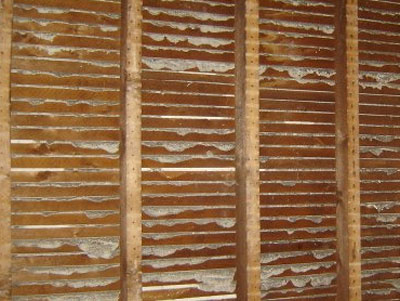Lathing
Lathing is the process of creating laths, which in traditional construction are parallel timber strips spaced apart to form the backing for another building component. They are usually nailed to timber uprights. The term derives from ‘plaster and lath’, where the laths were used as a support for wet plaster.
In Medieval housebuilding, wattle (as in ‘wattle and daub’ construction) comprised a lattice of wooden strips which was used as a backing for the daub – typically mud plaster. This can be seen as an early form of lathing.
‘Plaster and lath’ is frequently found in the internal partitions of Georgian, Victorian and Edwardian houses, and also in their ceilings. Typically, the timber laths are around 25mm wide by 6mm thick, and are positioned about 6mm apart to allow the plaster to penetrate into the gaps.
‘Lath and plaster’ was used right up to the early 20th century; but its use has now totally diminished due to the expense of wood, the labour needed and the time required for fixing. More importantly, the introduction of plasterboard offered a quick, direct and sturdy fixing to studs, thereby obviating the need for lathing.
Lathing today is mainly metal, comprising a diamond-pattern mesh of galvanised steel that is called expanded metal lath (EML). It is usually fixed with clout nails to the studs of timber partitions so that the long dimensions of the elongated ‘diamonds’ run horizontally. During fixing, the EML is made as taut as possible by nailing first in the centre and then stretching outwards before fixing at other points. The elongated diamond shape is regarded as being optimal as it best absorbs energy and resists deformation after being installed.
EML lathing can also be fixed to concrete blocks and bricks to form a backing for external render and stucco, and also for asphalt upstands. It is also used for wall reinforcement and to control cracking in brickwork and concrete.
[edit] Related articles on Designing Buildings Wiki
Featured articles and news
RTPI leader to become new CIOB Chief Executive Officer
Dr Victoria Hills MRTPI, FICE to take over after Caroline Gumble’s departure.
Social and affordable housing, a long term plan for delivery
The “Delivering a Decade of Renewal for Social and Affordable Housing” strategy sets out future path.
A change to adoptive architecture
Effects of global weather warming on architectural detailing, material choice and human interaction.
The proposed publicly owned and backed subsidiary of Homes England, to facilitate new homes.
How big is the problem and what can we do to mitigate the effects?
Overheating guidance and tools for building designers
A number of cool guides to help with the heat.
The UK's Modern Industrial Strategy: A 10 year plan
Previous consultation criticism, current key elements and general support with some persisting reservations.
Building Safety Regulator reforms
New roles, new staff and a new fast track service pave the way for a single construction regulator.
Architectural Technologist CPDs and Communications
CIAT CPD… and how you can do it!
Cooling centres and cool spaces
Managing extreme heat in cities by directing the public to places for heat stress relief and water sources.
Winter gardens: A brief history and warm variations
Extending the season with glass in different forms and terms.
Restoring Great Yarmouth's Winter Gardens
Transforming one of the least sustainable constructions imaginable.
Construction Skills Mission Board launch sector drive
Newly formed government and industry collaboration set strategy for recruiting an additional 100,000 construction workers a year.
New Architects Code comes into effect in September 2025
ARB Architects Code of Conduct and Practice available with ongoing consultation regarding guidance.
Welsh Skills Body (Medr) launches ambitious plan
The new skills body brings together funding and regulation of tertiary education and research for the devolved nation.
Paul Gandy FCIOB announced as next CIOB President
Former Tilbury Douglas CEO takes helm.
UK Infrastructure: A 10 Year Strategy. In brief with reactions
With the National Infrastructure and Service Transformation Authority (NISTA).























